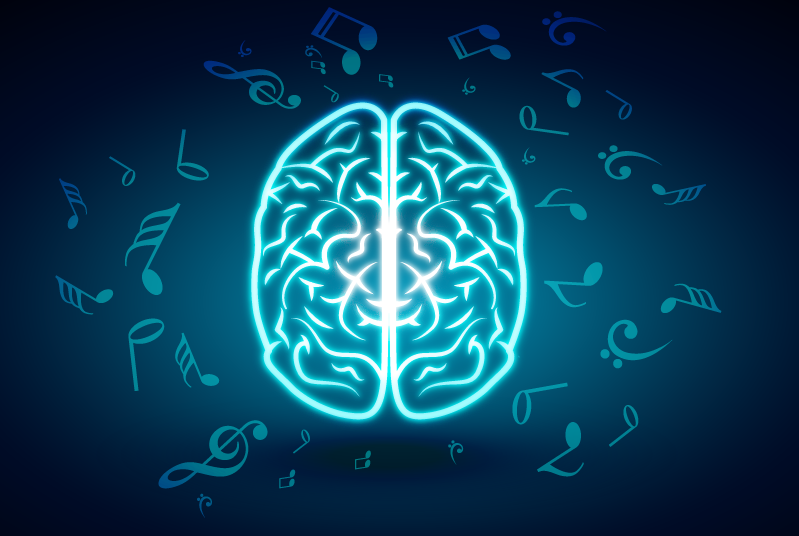Your Brain on Music: Effects of Music Therapy on Different Functions of the Brain

Your Brain on Music: Effects of Music Therapy on Different Functions of the Brain
Keywords
Musical interactions help facilitate changes in emotion, cognition, attention, behavior, and communication. Thomas Hillecke and colleagues presented a “Heuristic Working Factor Model for Music Therapy” that assumes how each of these factors contributes to the effects of music therapy. Throughout this article, we will explain how music can impact each factor of these one by one.
Music distracts attention from stimuli that are likely to cause negative feelings (e.g. anxiety, sadness, pain, etc.) as it automatically attracts attention. Changes in emotion are explained by studies using functional neuroimaging which have shown that music can modulate activity of all major limbic- and para-limbic brain structures. These brain structures are involved in the initiation, generation, maintenance, termination, and modulation of emotions. Such findings were beneficial for music-therapeutic approaches for the treatment of a type of disorders known as affective disorders (i.e. mood disorders), such as depression, pathologic anxiety, and post-traumatic stress disorder (PTSD) because these disorders are partly related to dysfunction of limbic structures, such as the amygdala (responsible for emotional processing and emotional tension and involved in fear), and para-limbic structures, such as the orbitofrontal cortex (involved in emotional processing and expression). “Systematic knowledge of the effects that music listening and music making have on these systems is still lacking, but because of the power of music to evoke emotions, it is conceivable that music therapy can be used for the treatment of disorders related to dysfunctions and dysbalances within these systems.” (Koelsch, 2009).
Effects of music therapy on cognition mainly include effects on memory processes. Another effect of music is related to communication modulation. As music is considered a tool of communication, especially active music therapy (in which clients practice music) can be used to train skills of nonverbal communication. Music therapy can be used for the treatment of communication disorders, such as selective mutism (an anxiety disorder in children featured by inability to communicate and speak in social settings). Markedly, this effect is also related to social cognition: listening to music produced by other people engages cognitive processes which attempt to understand the intentions and desires of those who produced the music. This feature can be used by music therapy for the treatment of autism or conduct disorders (a range of emotional and behavioral problems which occur in children and adolescents).

According to Stefan Koelsch’s study on Music Therapy and Neuroscience, “Music listening -and also music making- activates plenty of brain structures involved in cognitive, sensorimotor, and emotional processing. For instance, music engages sensory processes, attention, memory‐related processes, perception‐action mediation (“mirror neuron system” activity), multisensory integration, activity changes in core areas of emotional processing, processing of musical syntax and musical meaning, and social cognition. It is assumed that the engagement of these processes by music can have beneficial effects on the psychological and physiological health of individuals, although the mechanisms underlying such effects are currently not well understood.”
Last but not least, one of the many brain functions which music has effects on is emotional processing. “Previous functional neuroimaging studies have shown that listening to music affects the activity of all limbic and paralimbic structures (that is, of core structures of emotional processing) in both musicians and in so-called nonmusicians.” A study by Koelsch et. al investigated brain responses to joyful dance tunes and unpleasant dissonant counterpart of this dance music. They found that activity in limbic and paralimbic structures changes in response to music. “Unpleasant music elicited increases in blood-oxygen-level-dependent (BOLD) signals in the amygdala, the hippocampus, the parahippocampal gyrus, and the temporal poles (and decreases of BOLD signals were observed in these structures in response to the pleasant music). During the presentation of the pleasant music, increases of BOLD signals were observed in the ventral striatum” (Koelsch, 2009). This study led to the conclusion that listening to pleasant music has effects on the amygdala, ventral striatum and hippocampus, and that these structures play a consistent role in the emotional processing of music.
References
Baker, F. (2013). Book Review. Psychomusicology: Music, Mind, and Brain. Retrieved May 1, 2018
Croom, A. (2015). Music practice and participation for psychological well-being: A review of how music influences positive emotion, engagement, relationships, meaning, and accomplishment. Musicae Scientiae, Retrieved May 1, 2018
Koelsch, S. (2009). A Neuroscientific Perspective on Music Therapy. Department of Psychology, University of Sussex, Falmer, Brighton, United Kingdom. Retrieved May 8, 2018
Music and the brain (Online discussion #1) (2017). DR. JONES’ MUSIC CLASSES. Retreived April 13, 2021, from https://drjonesmusic.me/2017/08/29/music-and-the-brain-online-discussion-1/
MUSIC THERAPY AND MENTAL HEALTH. American Music Therapy Association, Inc. Retrieved May 1, 2018
Related articles
The Brain on Porn: Desensitization and Porn

5 Misconceptions of Therapy Explained

Hold the Reins: Anger Management

The War in Your Brain, How Do We Interact With Violent And Distressing Imagery?





